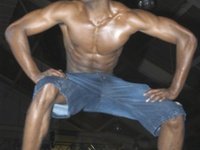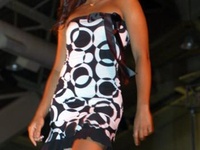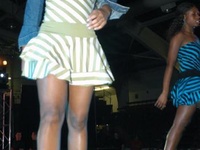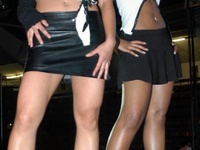Another controversial paradox of the era, female empowerment through sexual authority, was illustrated in homages to Charlie’s Angels and Pam Grier. At least for the ladies, the paradox of simultaneous empowerment and objectification subtly prevailed, particularly in the striking Angels poses, a testament to “those strong, hot women who owned their sexiness.”
Topping off the steamy, holler-inducing sequence, the Caribbean Club Dance Troupe contributed a distinct tropical spice to their reggae-seasoned routine.
The raucous audience enthusiasm continued into the next theme of “Boogie Nights,” which celebrated the 70s theme of stylistic excess manifested in flashy clothes and absurdly over-the-top hairstyles. Noticeable throughout the show was the pairing off of couples of different ethnic backgrounds, and the multiracial aspect wasn’t lost on Ardrey and Melvin. Playing up the lame Caucasian stereotype, they directed David A. Wallach ’07 in vaulting himself through Studio 54’s velvet ropes, after which he was carried off the stage by Mike Beal ’06 and Jason W. Norman ’05.
The Harvard Steppers were also in full effect, sporting coordinated gray camouflage and only breaking their synchronized thunder to chant, “Get yo Jollies!” in anticipation of the Black Men’s Forum dance the following night.
But it was the final scene of the “80s Dance” that brought the crowd’s loudest reaction. The set was kicked off by Senior Class Marshall Shaka J. Bahadu ’04, who expressed his affection for the women in the audience and the floor with classic Prince eroticism, while Hank Wilkins ’04 suffered for glory in sporting the tightest jeans a man has ever had to wear while performing to “I Would Die 4 U.”
The Harvard Breakers Organization who were at Eleganza last year brought back the staple of a clubber’s diet in an incredible display of breakdancing from members such as James C. Lee ’06 and Brian D. Lee ’06. Particularly memorable was the show’s finale, which gathered all the models back on stage in their loudest period clothes to cheer on Kwame Owusu-Kesse ’06 and Nicholas H. Barnes ’05 as they mirrored each other in checkered leather jackets while dancing to Bel Biv Devoe’s “Poison.”
Models in theory but performers in practice, these students were clearly the centerpiece of the production, say Ardrey and Melvin.
“In Eleganza, we recognized a forum for creative expression that is not usually available at Harvard,” says Melvin. “We then set about collecting a team of amazing and talented individuals from a variety of backgrounds and experiences who rarely found outlets for their creative voices.”
The models found a space which allowed elegance and burlesque to thrive, often strutting the runway with the kind of seriousness befitting an haute couture show, then infusing their act with a jaunty cheekiness (particularly in the case of Ryan P. Lannon ’05, who at one point in the show, bared his assets).
“Having the models see the runway was such a rush too, because they’re amazing and they’re devoting their time, and time is the most important thing you can give here,” says Melvin.
A Family Affair
Combining a business savvy with creative ingenuity, the group called upon various financial and creative sources to support the $15,000 production. The main sources of funding were “partly the U.C. and sponsorships,” says BlackCAST treasurer Abdel Reid ’06, “but also ticket sales—the models just selling, being out there.”
The persistent campaigning translated into greater financial freedom for staff and crew—something that Ardrey found integral to situating Eleganza in its hockey-rink venue. “Just being able to have things like a movement specialist for the scenes, having someone just showing the models how to move allowed for so much more creativity,” says Ardrey.
“It was quite an intense process to get clothing from stores,” says fashion coordinator Tessa C. Petrich ’04. Using a leasing policy, the fashionistas of the production were able to borrow clothing in exchange for publicity, and the larger budget also allowed insurance policies to be taken out in order to “assuage the concerns of store owners.” All 70 models were measured, and the clothing picked out from various outlets such as Jasmine Sola, Cibeline, Hubba Hubba, Proletariat, and Planet Aid.
A crew of 30 assembled the open free-standing “U” on which the lighting was rigged, as well as the monstrous “I”-shaped stage, which supported a 40-foot long runway and a 48-foot wide mainstage. A more substantial budget also brought in companies such as East Coast Lighting to coordinate the complex light show and expand the creative boundaries of the show’s visual aspect.

















